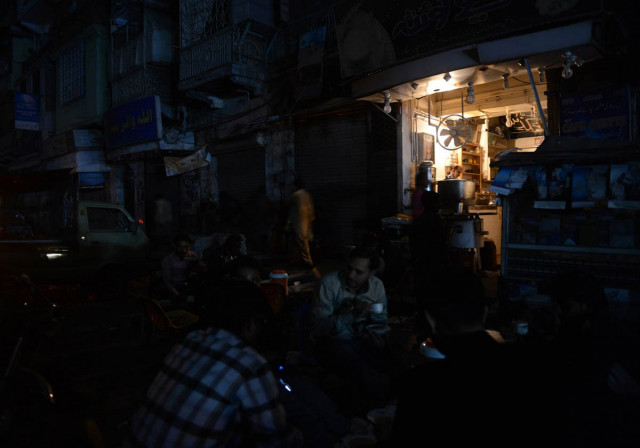Second day: Sindh, Balochistan grapple with blackout’s after-effects
K-Electric, Hesco, and NTDC scrambling to fix problem; Karachi faces water shortage

This was the fifth major breakdown since December 2014. PHOTO: AFP
The fallout from Tuesday night’s massive power breakdown, which plunged large parts of Sindh and Balochistan into darkness, continued to be felt on Wednesday with sporadic outages hampering routine life and highlighting the crumbling infrastructure of the nation’s electricity grid.
This was the fifth major breakdown since December 2014. The last such outage occurred in January 2015 when almost the entire country plunged into darkness due to cascading tripping of power plants.\
Read: Tripping of transmission lines, power plants plunge parts of Sindh, Balochistan into darkness
“We can't blame anyone except the fact that we are so busy fire-fighting small challenges on a daily basis that the persistent problems are ignored,” said a senior official of one power generation company, which was also effected due to the breakdown.

According to Wapda and K-Electric officials, gusty winds blew off about a dozen 500kv transmission-line towers of the National Transmission and Dispatch Company (NTDC) in Sehwan.
This led to the collapse of the Jamshoro to Guddu circuit – a network of power lines used to transport electricity. “Every power plant has a certain tolerance level and wild fluctuations, like they happened now, caused them to trip,” said the official.
K-Electric’s power plants in Bin Qasim, which account for most of the electricity it generates, went offline as a consequence.
Plants operate at a frequency of 50 hertz. They are designed to handle variation of 3% to 4% but anything more than that causes them to trip. In case a transmission tower falls, a low frequency signal travels back to the plant, which in turn tries to keep up with demand and ultimately fails. Every power plant is designed to meet certain requirements of the national grid depending on its location and how far the energy needs to be transported.
“The fluctuation was so severe that it even caused generators of Hub Power Company to trip,” officials say.
In its official statement K-Electric, the utility that supplies electricity to the country’s financial capital and its surrounding regions, said the sudden disruption of supply technically tripped the entire system to which the power utility and generation companies of Karachi and Sindh are connected.
Industry experts say the government can take steps to avoid these recurring outages, especially breakdowns of transmission lines. “The [state-owned] National Transmission and Dispatch Company (NTDC) should take these lines underground. This is something doable, which will yield long term benefits.”
Besides Karachi, almost all the 14 districts, or at least large parts of those districts, supplied electricity by state-owned Hyderabad Electric Supply Company (Hesco), were also without electricity for the entirety of Tuesday night. The breakdown, reportedly, continued through Wednesday afternoon in various districts.
“Since yesterday Hesco has been disconnected from the national grid [due to the 13 towers of the NTDC],” Hesco spokesman Sadiq Kubar told The Express Tribune. He believed it will take at least three days for the NTDC and two days for Hesco to fix the towers.
Complaints of prolonged outages continued to pour in Wednesday from many parts of Sindh. “We didn’t have light both at Iftari time yesterday and Sehri today,” said Fahad Nizamani, a resident of Tando Allahyar district.
Read: Boomerang effect: Blackout cuts off city’s water supply
In Karachi, the recurrent outages tested peoples’ nerves as K-Electric’s wires and pole mounted transformers in many areas broke down as soon as power was restored.
In Karachi, the power outages resulted in water shortages, as the city’s five pumping stations shut down. The main pumping stations, Dhabeji, Gharo, Pipri, Hub and North-East Karachi, suspended their operations which led to a shortage of 525 million gallons per day (MGD).
“All the main sources of water were suspended and it will take three to four days to normalise the gap in water supply,” said Karachi Water and Sewerage Board (KWSB) technical deputy managing director Iftikhar Ahmed. “The water supply that starts from near Kalri Lake takes around 18 hours to reach the city,” he pointed out. “The system has been emptied now and it will take time to build up the pressure again to restore proper supply.”
Many residents were forced to sacrifice on their sleep when the power supply showed no signs of returning on Tuesday night. Preferring to have Sehri outside her home, a Gulshan-e-Iqbal resident Sanjida decided to take her family to a nearby KFC outlet. “KFC ran out of food so they had shut down and it was really difficult to find dining space at any other eatery,” she said.
Nazimabad resident Samina Shakir realised there was a power outage at 11 pm when she came home from Taraweeh prayers. “I went to sit on the rooftop along with everyone else from my apartments,” she said. “Everyone sat there till Sehri.”
The sea breeze made the weather slightly more bearable but many residents took it as an opportunity to shop for Eid.
Published in The Express Tribune, July 9th, 2015.



















COMMENTS
Comments are moderated and generally will be posted if they are on-topic and not abusive.
For more information, please see our Comments FAQ